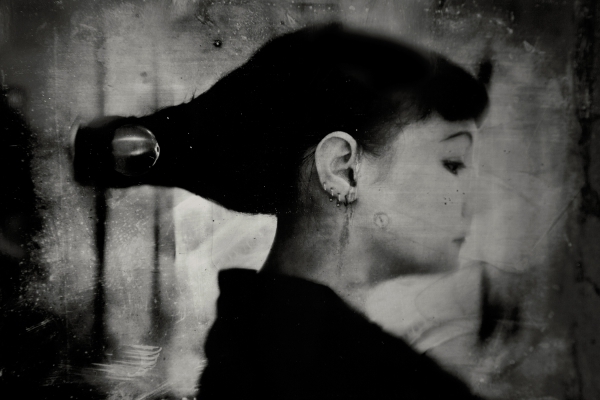BRATTLEBORO — The current show at the Vermont Center for Photography, “Soma,” recent photographs by Michelle Rogers Pritzl, is not “easy.” It doesn't go down as smoothly as a beautiful landscape, close-up of a flower, or traditional portrait.
But these photographs are as important as they are edgy.
Looking in some instances like photos from a 19th-century chamber of tortures, the photographs are actually self-portraits of the artist which metaphorically depict the mental and emotional harm we inflict on ourselves, by carrying with us trauma or hurtful life events.
Although she has used herself as model, the photos are not “me-specific,” says the artist.
“We all have had hard moments [...] or years,” she continues, emphasizing the images' supra-personal nature. “It's easy to get stuck in grief, but seeing you can make a choice to move forward, seeing there is a choice [...] was a profound realization for me.”
The titles of the photos are all turns of phrase taken from Sigmund Freud's Beyond the Pleasure Principle, a book that made a deep impression on Pritzl.
Not only did the book open a window into self and others that confirmed what she was seeing and experiencing, it turned out to be a creative wellspring.
The “Soma” images are far more than an exercise in psychological awareness, however exorcising or healing. The photographs are beautiful in their rich blacks, textures, and bright whites, which read like explosive moments of insight emerging from interior recesses. Her process employs an unusual concordance of 19th- and 21st-century techniques.
While living and teaching in California, Pritzl was introduced to the tintype at a workshop given by photographer Allan Barnes.
“The moment I felt the metal in my hands, I knew this was what I wanted to do,” she said.
Pursuing the technique further, she found Christopher James's book, The Book of Alternative Photographic Processes.
Eventually she returned to school, to Lesley University's College of Art and Design in Cambridge, Mass., to study with James.
She received a Master of Fine Arts in photography, with “Soma” as her thesis project. It has been shown in several galleries and museums of photography from Boston to Colorado.
* * *
Pritzl's compelling images of an interior landscape are haunting personal statements. Yet they have a resonance, I believe, for many women coming to grips with their psychological history, and they are made immeasurably more resonant by the artist's photogenic qualities.
“It was almost an accident, using myself as a model. I was a recent arrival in Boston when I started these,” she says. “I didn't know anyone I could ask to model, and so I locked myself in a room and started creating.”
As it turns out, Pritzl as model creates a perfect tabula rasa for her scenarios. Delicate and fine-featured, the subject could easily be an idealized portrait from the turn of the 20th century, or one of Salvador Dalí's impassive women in his surreal compositions.
Furthermore, locking herself up in a small space and using only herself as model has imbued the photographs with an intimacy and claustrophobic quality that suit the subject matter.
In the tintype technique, collodion and silver nitrate are each poured on a metal plate. (Pritzl likes to use trophy metal, which is already blackened.) The way these elements go on the plate affects texture and the distribution of white and dark areas. The silver nitrate can dip, pool, etc., which leaves its traces.
In one photograph, “Restoration of an Earlier State,” the liquid used in rendering the plate light-sensitive has left streaks across the image that create almost an underwater effect - a figure places glass cups, the kind used in alternative healing, along her back. The glass shimmers under faint ripples formed by the drips of nitrate.
But Pritzl is not trying to be anachronistic.
“I love working now,” she said. “There are so many techniques available. I love combining them.”
Pritzl's work at the Vermont Center for Photography is an achievement. She has created a series of images that are stylistically original, eminently photographic, and emotionally powerful.
